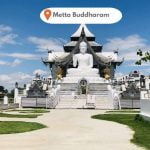Nestled in the heart of Bihar, Bodhgaya is one of the most sacred places in the world and a beacon for Buddhist pilgrims from every corner of the globe. This is the land where Prince Siddhartha attained enlightenment under the Bodhi Tree, transforming into Lord Buddha, and igniting a spiritual movement that would impact all of humanity. A heritage walk through Bodhgaya is more than a tour—it is a journey through time, tradition, and transformation.
Let us guide you through an immersive Bodhgaya Heritage Walk, uncovering the spiritual, architectural, and cultural layers of this UNESCO World Heritage site and beyond.
Bodhgaya Heritage Walk

1. Mahabodhi Temple Complex – The Spiritual Core
Begin your walk at the Mahabodhi Temple, a towering architectural marvel and the heart of Bodhgaya. Built by Emperor Ashoka in the 3rd century BCE and later reconstructed, this UNESCO-listed structure is a sacred symbol of Buddhist devotion.
Must-See Highlights:
- Vajrasana (Diamond Throne): The sacred spot where Buddha meditated and achieved enlightenment.
- Bodhi Tree: A direct descendant of the original tree, still flourishing in silent wisdom.
- Inner Sanctum & Carvings: Intricate carvings depict scenes from Buddha’s life.
- Sacred Pond & Lotus Fountain: A serene space for reflection and prayer.
- Pro tip: Visit during the early morning aarti or in the evening when monks from across the world chant in unison—it’s a transcendent experience.
2. Animesh Lochan Chaitya – The Watchful Gaze
Just north of the Mahabodhi Temple is Animesh Lochan Chaitya, a site that commemorates the Buddha’s unblinking meditation as he gazed at the Bodhi Tree in gratitude. According to tradition, he stood here for a week without blinking, reflecting on the truth he had realized.
This site evokes reverence and invites deep meditation, symbolizing the Buddha’s humility and awareness.
3. The Seven Weeks (Saptasthana) Sites
Bodhgaya preserves seven sacred spots where Buddha spent seven weeks after his enlightenment, each dedicated to contemplation and gratitude. These sites form the sacred geography of Buddhist devotion.
The Seven Sites Include:
- Week 1: Vajrasana under the Bodhi Tree.
- Week 2: Animesh Lochan Chaitya.
- Week 3: Ratnachakarma (Jewelled Walk).
- Week 4: Ratanaghara.
- Week 5: Ajapala Nigrodha Tree.
- Week 6: Mucalinda Lake.
- Week 7: Rajayatana Tree.
Walking through these places offers a chronological spiritual narrative, a rare pilgrimage in motion.
4. Sujata Garh – A Symbol of Compassion
Crossing the Falgu River, a short walk or tuk-tuk ride will take you to Sujata Garh, a peaceful mound believed to be the home of Sujata, the woman who offered milk-rice to Siddhartha before his enlightenment. Her simple act of compassion ended his severe asceticism and set the foundation for the Middle Path in Buddhism.
Nearby, the Sujata Stupa, built by Emperor Ashoka, marks her contribution and compassion. It’s a humbling place that reflects the value of kindness in spiritual awakening.
5. International Monasteries – A Global Footprint
One of the most fascinating parts of the Bodhgaya Heritage Walk is the cluster of monasteries and temples established by Buddhist countries around the world. Each reflects the architectural and cultural traditions of its homeland while honoring the teachings of the Buddha.
Must-Visit Monasteries:
- Thai Monastery: Ornate carvings and golden-roofed pagodas.
- Japanese Temple: A peaceful Zen garden and a towering statue of Buddha.
- Tibetan Monastery: Colorful prayer flags and wheel drums.
- Bhutanese Temple: Impressive woodwork and traditional Dzong architecture.
- Vietnamese Temple: Peaceful halls and intricate Buddhist iconography.
These monasteries make Bodhgaya a truly international center of Buddhism, uniting traditions from Sri Lanka to Mongolia in a single spiritual space.
6. Great Buddha Statue – The Giant Sentinel
No heritage walk in Bodhgaya is complete without visiting the Great Buddha Statue, an 80-foot tall seated Buddha built in 1989. Made of sandstone and red granite, it took seven years and the efforts of thousands of artisans to complete.
Surrounding the statue are smaller images of the Buddha’s ten principal disciples, making this a powerful site of inspiration and global Buddhist craftsmanship.
7. Archaeological Museum – Preserving the Past
Just a short distance from the Mahabodhi Temple, the Bodhgaya Archaeological Museum houses a vast collection of ancient relics, stone carvings, inscriptions, and sculptures.
What to Look For:
- Images of Buddha and Bodhisattvas from the Pala period.
- Terracotta plaques and votive stupas.
- Tools and relics used by ancient monks.
The museum offers a historical context to your spiritual journey, connecting the modern city with its ancient roots.
8. Meditation Parks & Dhamma Centers
End your heritage walk with introspection. Bodhgaya is home to many meditation centers that welcome spiritual seekers.
Popular Retreat Spaces:
- Tergar Monastery: Led by Yongey Mingyur Rinpoche, this center blends tradition with modern mindfulness.
- Root Institute for Wisdom Culture: Offers meditation, yoga, and Buddhist philosophy courses.
- Dhamma Bodhi Vipassana Centre: Dedicated to the Vipassana tradition taught by S.N. Goenka.
These centers provide tools to deepen your spiritual experience beyond sightseeing, helping visitors connect with the inner path of the Buddha.
9. Local Markets – The Spiritual Souvenir Trail
The streets around Bodhgaya buzz with spiritual energy and artisanal charm. A walk through the local markets reveals a treasure trove of:
- Buddhist artifacts, thangkas, statues, and prayer wheels.
- Tibetan handicrafts, incense, and singing bowls.
- Books on Buddhist philosophy in multiple languages.
- Meditation clothing, shawls, malas, and more.
Shopping in Bodhgaya is not about luxury but about carrying home a piece of your spiritual journey.
Conclusion: Walking Through Enlightenment
The Bodhgaya Heritage Walk is a pilgrimage unlike any other. It bridges history, spirituality, art, architecture, and personal reflection. Every corner of this sacred town is soaked in the essence of enlightenment, offering the traveler not only a view of the past but an invitation to live mindfully in the present.
This journey is for everyone—pilgrims, scholars, solo seekers, and curious minds. As you walk these sacred paths, remember: you’re not just exploring a place—you’re walking in the footsteps of the Buddha.




